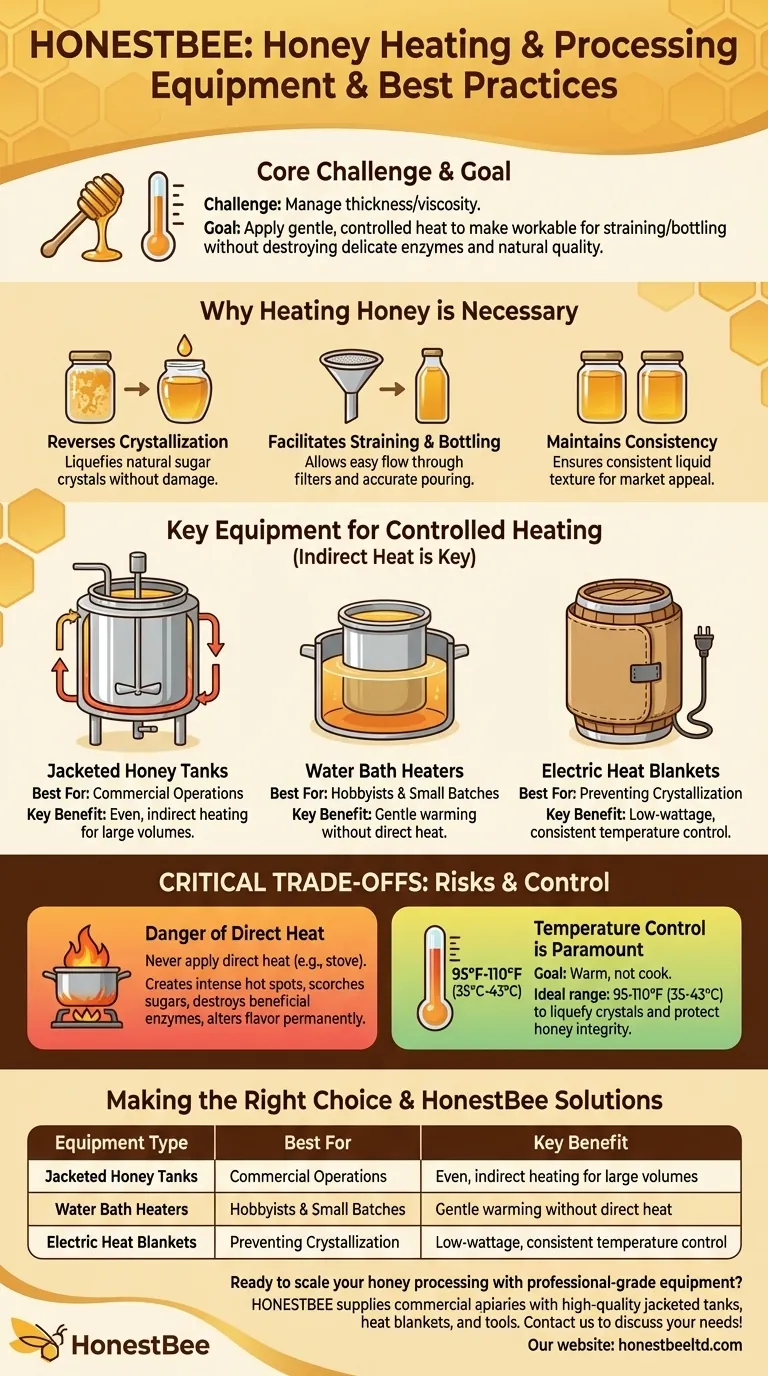The most common equipment for heating and processing honey includes specialized honey tanks, water bath heaters, and electric heat blankets. For larger operations, this includes jacketed tanks with hot-water circulation and stirrers that provide even, indirect heat, which is essential for preparing honey for bottling and distribution.
The core challenge in processing honey is managing its thickness, or viscosity. The goal is to apply gentle, controlled heat to make the honey workable for straining and bottling without destroying its delicate enzymes and natural quality.

Why Heating Honey is Necessary
The primary reason for warming honey is to reverse its natural crystallization process and reduce its viscosity. This makes an otherwise thick, semi-solid product fluid enough to handle.
The Problem of Crystallization
Honey is a supersaturated sugar solution that will naturally crystallize over time. Warming it gently and carefully re-liquefies these crystals without damaging the product.
Facilitating Straining and Bottling
Thick, crystallized honey is nearly impossible to strain or bottle cleanly. Heating it allows it to flow easily through filters to remove wax and other debris and to be poured accurately into containers.
Maintaining Consistency
For commercial producers, ensuring a consistent, liquid product is crucial for market appeal. Controlled heating helps achieve the desired texture and clarity that consumers expect.
Key Equipment for Controlled Heating
The right equipment depends entirely on the scale of your operation. The unifying principle across all methods is the use of gentle, indirect heat to avoid scorching the honey.
Jacketed Honey Tanks
These are the standard for commercial-scale operations. A tank holding the honey is surrounded by an outer "jacket" through which warm water circulates. This provides slow, even heating with no hot spots. Many also include a central stirrer to ensure uniform temperature throughout the batch.
Water Bath Heaters
This method involves placing a container of honey into a larger vessel of warm water. It's a highly effective way to gently warm honey without direct heat, preserving its quality. This can be a dedicated piece of equipment or a simple DIY setup for hobbyists.
Electric Heat Blankets
These are insulated blankets or belts that wrap around a bucket, drum, or tank. They use low-wattage heating elements to maintain a consistent temperature, which is especially useful for preventing crystallization during cold months or gently liquefying honey over several hours.
Understanding the Critical Trade-offs
Improper heating is the fastest way to ruin a batch of honey. Understanding the risks is key to preserving the value of your harvest.
The Danger of Direct Heat
Never apply direct heat to honey, such as placing a pot on a stove. This creates intense hot spots that will scorch the sugars, destroy beneficial enzymes, and permanently alter the flavor for the worse.
Temperature Control is Paramount
The goal is to warm, not cook. Overheating can darken the honey's color and degrade its delicate aromatic compounds. The ideal temperature range is typically between 95°F and 110°F (35°C and 43°C), which is warm enough to liquefy crystals but low enough to protect the honey's integrity.
Efficiency vs. Scale
A simple heat blanket is perfect for a hobbyist with one or two buckets, but it's completely inefficient for a commercial operation processing hundreds of gallons. Jacketed tanks are a significant investment but are essential for handling large volumes efficiently and safely.
Making the Right Choice for Your Goal
Your equipment choice should directly align with the scale of your operation and your commitment to quality.
- If your primary focus is small-scale hobby beekeeping: An electric heat blanket or a simple water bath setup provides the gentle, controlled warming you need to process a few buckets at a time.
- If your primary focus is a growing side-business: Investing in a dedicated warming cabinet or a smaller, thermostatically controlled tank will give you better consistency and efficiency.
- If your primary focus is commercial production: Jacketed, agitated honey tanks are the industry standard and a necessary investment for processing large volumes while maintaining quality control.
Ultimately, selecting the correct heating method is fundamental to protecting the natural quality and value of your honey.
Summary Table:
| Equipment Type | Best For | Key Benefit |
|---|---|---|
| Jacketed Honey Tanks | Commercial Operations | Even, indirect heating for large volumes |
| Water Bath Heaters | Hobbyists & Small Batches | Gentle warming without direct heat |
| Electric Heat Blankets | Preventing Crystallization | Low-wattage, consistent temperature control |
Ready to scale your honey processing with professional-grade equipment?
HONESTBEE supplies commercial apiaries and beekeeping equipment distributors with high-quality, wholesale-focused honey processing solutions. Our jacketed tanks, heat blankets, and other essential tools are designed to help you maintain honey quality while boosting efficiency.
Contact us today to discuss your needs and get a quote tailored to your operation!
Visual Guide

Related Products
- Professional Thermostatic Conical Honey Melter
- 10L Stainless Steel Electric Honey Press Machine
- Honey Concentrating Vacuum Heating Thickening Machine Dehumidifier for Honey
- 8-Frame Electric Self-Reversing Honey Extractor Spinner for Commercial Honey Extraction Equipment
- Plastic Honey Gate Spout with Wing Nut for Beekeeping Honey Bucket
People Also Ask
- What is melter honey used for? A Low-Cost Ingredient for Bakers and Brewers
- What are the negative effects of overheating honey? Preserve Your Honey's Natural Quality
- Why is it important to heat honey slowly and evenly? Preserve Flavor, Nutrients & Value
- What is the effect of heating on honey? Preserve Quality with Controlled Warming
- Why is heating honey sometimes necessary? The Essential Guide to Processing & Quality



















